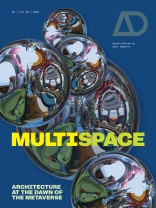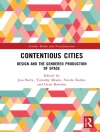Guest-edited by Owen Hopkins
Multispace exists at the intersection of the physical and digital, and in the blurring of their previously clear dividing lines. Multispace is not a single space, but a hybrid space where, in effect, we occupy multiple spaces simultaneously. We enter it on a Zoom call, when we are in our office and in a meeting with 20 people; when we are cycling down a country lane whilst racing against thousands of others who also use the Strava app; when we are watching a TV show while live tweeting; or, perhaps most literally, when wandering around the local park looking for creatures that only appear on a smartphone screen.
A fundamental question of this AD is why the phenomena that multispace describes are of concern to architects. The answer is that multispace points to a situation that is at root an architectural one. Offering both a collective and highly personalised experience, static and dynamically customisable, and above all at the same time public and private, multispace lies at the centre of a set of tensions, concerns and preoccupations at the core of our conception of architecture as theory and practice. It is the messy space between, with rough and uneven edges that are constantly shifting.
Contributors: Aleksandra Belitskaja, Alice Bucknell, Jesse Damiani, Wendy Fok, Andrew Kovacs, Lara Lesmes and Fredrik Hellberg, Micaela Mantegna, Holly Nielsen, Giacomo Pala, Paula Strunden, Lucia Tahan, and Francesca Torello and Joshua Bard.
Featured architects and artists: iheartblob, Ibiye Campis, Office Kovacs, Space Popular and Liam Young.
Tabla de materias
About the Guest-Editor 5
Owen Hopkins
Introduction Architects in Multispace 6
Owen Hopkins
The Portal Galleries: Researching Portals in Fiction from the 19th Century to the Present 14
Lara Lesmes and Fredrik Hellberg
The Home as an Infinite Screen 22
Lucia Tahan
Hidden Infrastructures: From ‘Spy-Hubs’ to Hollow Buildings that Conceal the New Digital 30
Wendy W Fok
Architecture in Postreality: Emerging Approaches to Space in Hybrid Realities 38
Jesse Damiani
Touching, Licking, Tasting: Performing Multisensory Spatial Perception Through Extended-Reality Models 48
Paula Strunden
Multipurpose Domesticity: Labour, Leisure and Kitchen Tables 56
Holly Nielsen
Conjunctions: Or, Space as Oxymoron 64
Giacomo Pala
Celebrating the Glitch: The Multispatial Work of Ibiye Camp 72
Owen Hopkins
Architecture is Interface: Latent Virtuality from Antiquity to Zoom 78
Joshua Bard and Francesca Torello
Very Big Art: Follies, the Public and Multispace 86
Andrew Kovacs
Ways of Worlding: Building Alternative Futures in Multispace 94
Alice Bucknell
The Anti-Metaverse: Multispace and the Intersections of Reality 104
Micaela Mantegna and Marcelo Rinesi
All At Once – From Zoom Fatigue to Immersive Digital Experiences: Why Architecture Must Adapt 112
Sasha Belitskaja
Shifting Contexts: Liam Young’s Prototypes of Architectural Futures 122
Owen Hopkins
From Another Perspective – The Haçienda Must Be Built 128
Neil Spiller
Contributors 134
Sobre el autor
Owen Hopkins is an architectural writer and curator. He is Director of the Farrell Centre at Newcastle University. Previously he was Senior Curator of Exhibitions and Education at Sir John Soane’s Museum and before that Architecture Programme Curator at the Royal Academy of Arts. He is curator of numerous exhibitions including most recently
Langlands & Bell: Degrees of Truth (2020). A frequent commentator on architecture in the press, on radio and TV, he is author of seven books, including
The Museum: From its Origins to the 21st Century (2021),
Postmodern Architecture: Less is a
Bore (2020),
Lost Futures (2017),
Mavericks (2016) and
From the Shadows (2015), and editor of a further eight books / journal special issues / digital publications. He lectures internationally and is a regular guest critic at architecture schools as well as a judge for several architecture awards.












